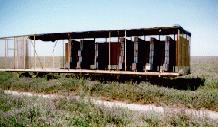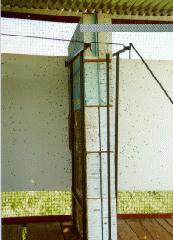Leafcutting Bee Incubation Calendar
Leafcutting Bee X-ray Analysis
Leafcutting Bee Gallery
Leafcutting Bee Publications
Lifecyle
 Mature Larva – The Leafcutting Bee overwinters as a mature larva. Storage at 50ºF prevents development.
Mature Larva – The Leafcutting Bee overwinters as a mature larva. Storage at 50ºF prevents development.- Pupa – When temperatures increase in the spring, the larvae begin to develop and pupate. Development is fastest at 86ºF. The incubation period lasts from 3 to 4 weeks.
- Adults, first generation – The pupae give rise to adults which must chew their way out of their cocoons. Males emerge first after about 18 to 20 days of incubation. Females emerge from 21 to 24 days after incubation.
- Egg – Females mate immediately after emerging. They then select a hole and begin to provision cells. Eggs are present a few days after females begin flying. A female can construct one to two cells per day, depending on conditions. Each cell is made up of a leaf-lined cup packed partially with pollen. The bee deposits a small droplet of nectar on the surface of the pollen and lays the egg in the nectar.
- Mature Larva – Larvae reach maturity in about 3 weeks, depending on temperature. The larva will then either proceed into diapause (a hibernation-like state in which they overwinter) or they will continue developing to produce a second generation.
- Pupa – When pupae are found in the nests, they will inevitably hatch as second generation adults. In warmer climates such as California, 40 to 80% of the larvae may develop into second generation.
- Adult – These second generation adults appear about a month after eggs are laid. These adults will readily use the nest holes from which they emerged.
- Egg – Eggs are laid by second generation adults within a few days of nesting. These eggs will hatch and the larva will mature and go into diapause. A small percentage will continue to develop and create a third generation. These adults emerge in late August and September, too late for alfalfa pollination. The diapausing larvae can then be held in cold storage until the following spring when they can be incubated.
Alfalfa Leafcutting Bee Management
The alfalfa leafcutting bee (Megachile rotundata) is a solitary bee that makes its nests in preexisting holes. Unlike the honeybee, the leafcutting bee has no queen or division of labor.
The leafcutting bee is smaller than the honeybee, about 3/8” in length. Each bee fends for itself though they are gregarious. The females use leaf pieces that they cut with their sharp mandibles to line their nests. The bees collect pollen and nectar and pack it into a doughy ball into which they lay their eggs. While honeybees load pollen onto their hind legs, the leafcutting bees brush the pollen onto the underside of their abdomen where stiff hairs hold the pollen. In the life cycle of the alfalfa leafcutting bee there is typically one generation per year, but can have two or three generations in warmer climates, such as in California. The leafcutting bee overwinters as a mature larva inside a cocoon made of silk and covered in leaf pieces.
In the spring the cocoons need to be incubated in order for adults to emerge at the right time. It takes approximately 21 days at 30ºC (86ºF) for adults to emerge. The bees can be incubated the nesting material where they were deposited or they can be stripped from their holes and incubated as loose cells. When the bees are ready to emerge from their cells, they are taken to r field and released. Nests need to be protected from direct sunlight and rain. Wood or Styrofoam nests are accepted readily. Many hole sizes will also be accepted but holes that are between 2.5 to 4 inches deep and 0.25 inch in diameter will provide optimal nesting. For alfalfa seed, bees are stocked at the rate of 2 to 5 gallons (20,000 to 50,000 bees) per acre. Because only about 30% of the bees are female, this equates to 6,000 to 15,000 females per acre.
The leafcutting bee female has a stinger and will use it to defend herself. However, the leafcutting bee is not aggressive and does not defend its home, as the honeybee does. The sting of a leafcutting bee is about half as painful as a honeybees and they do not leave a stinger behind. Unlike honeybees, leafcutting bees do not die after stinging. No protective clothing is needed when working with leafcutting bees and the shelters do not pose any threat to the public, even when placed near homes.
Leafcutting bee shelters may be moved during the nesting period but moves should be done at night when all the bees are safely resting in their holes. Moves should also be least 1/4 mile, otherwise the bees may fly back to the original site of the shelter. The adults live for about 6 weeks. Once the flight activity has diminished, the nest boards may be removed from the field and stored. The cocoons should then be refrigerated over the winter either loose or inside the nesting boards.
The alfalfa leafcutting bee may also be used to pollinate some vegetable seed crops in cages. Tests have shown good pollination results in both onion and carrot seed.
References
Baird, CR D.F. Mayer, and R M Bitner. 1991. Pollinators. In Alfalfa Seed Production and Pest Management. Western Regional Extension Publication 12.
1995. Use of alfalfa leafcutter bee growing in California. Seed Trade News Vol. 1 16, No. 9, 1 14.
For more details on the alfalfa leafcutting bee, see:
Text of “Current Status of the Alfalfa Leafcutting Bee”



